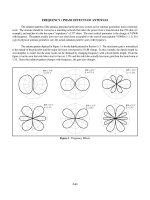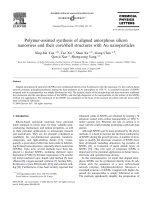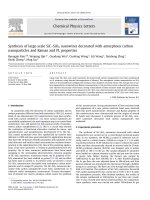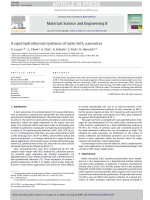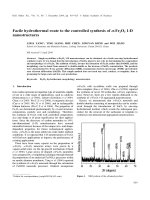Solid phase synthesis of αacylaminoα,α disubstituted ketones
Bạn đang xem bản rút gọn của tài liệu. Xem và tải ngay bản đầy đủ của tài liệu tại đây (201.02 KB, 5 trang )
Seediscussions,stats,andauthorprofilesforthispublicationat: />
Solidphasesynthesisofα-acylamino-α,αdisubstitutedketones
ARTICLEinTETRAHEDRONLETTERS·OCTOBER2002
ImpactFactor:2.38·DOI:10.1016/S0040-4039(02)01803-8
CITATIONS
READS
11
29
6AUTHORS,INCLUDING:
ColinMTice
ErnestoNicolás
53PUBLICATIONS815CITATIONS
UniversityofBarcelona
SEEPROFILE
57PUBLICATIONS775CITATIONS
SEEPROFILE
JavierGarcia
FernandoAlbericio
HospitalUniversitariodeSalamanca
UniversityofKwaZulu-Natal
28PUBLICATIONS866CITATIONS
778PUBLICATIONS12,626CITATIONS
SEEPROFILE
SEEPROFILE
Availablefrom:ErnestoNicolás
Retrievedon:10January2016
TETRAHEDRON
LETTERS
Tetrahedron Letters 43 (2002) 7491–7494
Pergamon
Solid phase synthesis of a-acylamino-a,a-disubstituted ketones
Colin M. Tice,a,* Enrique L. Michelotti,b,† Ernesto G. Mata,b,c Ernesto Nicola`s,d Javier Garciab,d and
Fernando Albericiod,*
a
RHeoGene Inc., PO Box 949, 727 Norristown Road, Spring House, PA 19477 -0949, USA
Rohm and Haas Company, PO Box 904, 727 Norristown Road, Spring House, PA 19477 -0904, USA
c
Instituto de Quı´mica Orga´nica de Sı´ntesis, CONICET-Universidad Nacional de Rosario, Rosario, Argentina
d
Department of Organic Chemistry, University of Barcelona, 08028 Barcelona, Spain
b
Received 12 August 2002; revised 23 August 2002; accepted 26 August 2002
Abstract—a-Acylamino-a,a-disubstituted ketones are of interest as ecdysone agonists. Solid phase synthesis of prototypical
a-acylamino-a,a-disubstituted ketones on two different solid supports is described. In both cases the ketone was formed by
reaction of a Grignard reagent with an N-acyl-a,a-disubstituted amino acid immobilized through its carboxylate as a Weinreb
amide derivative. © 2002 Elsevier Science Ltd. All rights reserved.
As part of a program to discover ecdysone agonists for
use in systems to control gene expression via natural
and engineered ecdysone receptors, we became interested in a-acylaminoketones of general structure 1.
With appropriate substituents at the R1, R1a, R2 and R3
positions, these compounds are potentially bioisosteric
with known diacyl hydrazine ecdysone agonists e.g. 2
(Fig. 1).1,2 To investigate this hypothesis we sought a
solid phase synthesis of 1 which would be sufficiently
general to allow production of a library of compounds
for biological screening.
Figure 1. a-Acylamino-a,a-disubstituted ketones 1 and diacylhydrazine 2.
Abbreviations: Aib, a-aminoisobutyric acid; DIC, N,N%-diisopropylcarbodiimide; EDC, 1-ethyl-3-(3%-dimethylaminopropyl)carbodiimide;
Fmoc, 9-fluorenylmethoxycarbonyl; HOAt, 1-hydroxy-7-azabenzotriazole; HATU, N-[(dimethylamino)-1H-1,2,3-triazolo[4,5-b]pyridino1-ylmethylene]-N-methylmethanaminium
hexafluorophosphate
N-oxide; i-Pr2Net, N,N-diisopropylethylamine; NMP, N-methylpyrrolidin-2-one; PAS-FTIR, photoacoustic Fourier transform infrared spectroscopy; TFA, trifluoroacetic acid; TFFH, tetramethylfluoroformamidinium hexafluorophosphate.
* Corresponding authors.
†
Current address: Locus Discovery Inc., Four Valley Square, 512
Township Line Road, Blue Bell, PA 19422, USA.
A number of solid phase syntheses of ketones,3–22
including a-acylaminoketones,10–22 have been reported
in the literature. The syntheses of a-acylaminoketones
have utilized a variety of strategies to link the synthetic
intermediates to the polymeric support including linking through the nitrogen,10–12 through a functional
group remote from the ketone,13–17 through the ketone
itself as a hydrazone derivative18–20 or employing a
carboxylic acid derivative as the incipient ketone.21,22
We were particularly attracted to the last approach
since it would allow complete construction of the
desired compounds 1 on solid phase (Scheme 1). Thus,
resin bound Weinreb amides 3 could plausibly be
assembled from N-protected a,a-disubstituted amino
acids 6 and carboxylic acids 7. Treatment of 3 with
Grignard reagents 4 should liberate the desired aacylaminoketones 1. Large numbers of carboxylic acids
7 and certain N-protected a,a-disubstituted amino acids
6 and Grignard reagents 4 are commercially available
rendering production of a large library a practical
undertaking. However, a,a-disubstituted amino acids
are known to be problematic in peptide synthesis
because of their steric bulk23 and we anticipated that we
might encounter similar difficulties using them. Furthermore, during the course of this work, O’Donnell
and Scott reported that t-BuMgBr failed to give any of
the desired ketone when reacted with a resin bound
intermediate not dissimilar to 3, suggesting that the
addition of a Grignard reagent to a resin bound Weinreb amide is susceptible to steric hindrance.22 Nonetheless, we embarked upon an effort to reduce the
0040-4039/02/$ - see front matter © 2002 Elsevier Science Ltd. All rights reserved.
PII: S 0 0 4 0 - 4 0 3 9 ( 0 2 ) 0 1 8 0 3 - 8
7492
C. M. Tice et al. / Tetrahedron Letters 43 (2002) 7491–7494
Scheme 1. Retrosynthesis of a-acylamino-a,a-disubstituted ketones 1.
approach outlined retrosynthetically in Scheme 1 to
practice, initially using the benzyloxyamino resin 8
reported by Salvino8 and subsequently employing the
commercially available Weinreb amide resin 13 developed by Martinez.24
Benzyloxyamino resin 8 (Scheme 2) was prepared from
Wang resin following the literature procedure8 and the
intermediates were characterized by PAS-FTIR.
Product resin 8 itself was characterized both by PASFTIR and by cleavage of a portion with TFA/CH2Cl2
(1:1) to afford C6H5CH2ONH2. Fmoc-Aib-OH (6a) was
selected as a prototypical a,a-disubstituted amino acid
for coupling to 8 and the extent of conversion of 8 to
9a was estimated based on PAS-FTIR.25 A number of
standard peptide coupling conditions were explored
and failed to give satisfactory conversion to the amide
9a (Table 1, entries 1–6). Use of the amino acid fluoride
prepared in situ using TFFH (entry 7) or isolated from
reaction of Fmoc-Aib-OH and DAST (entry 8)26
afforded slightly improved conversion. Proceeding
through the synthetic sequence with incompletely
loaded samples of 9a proved problematical. Benzyloxyamino groups that had not reacted with 6a were
available for coupling with benzoic acid (7a) affording
10 (Scheme 3). Grignard reagents effectively converted
10 to phenyl ketones 11. Finally, significantly improved
loading was effected using the symmetrical anhydride
of 6a, prepared in situ by treatment of 6a with 0.5
equiv. of DIC in a mixture of CH2Cl2 and DMF (entry
9).27 Submitting the resin to a second cycle of coupling
increased the level of conversion of 8 to 9a to 91%
(entry 10). The Fmoc protecting group was removed
from 9a under standard conditions and benzoic acid
was smoothly coupled to the free amino group using
DIC/HOAt to afford 3a. Resin bound intermediates 9a
and 3a exhibited satisfactory PAS-FTIR spectra. Treatment of 3a with excess EtMgBr afforded 1a in 60%
yield based on the initial functionalization of the resin.
The chemistry was successfully extended to aromatic
Grignard reagents. Reaction of 3a with excess of
PhMgBr afforded 1b in 31% yield. The major impurity
in the crude product was biphenyl derived from the
Grignard solution used. Examination of the spent resin
from this reaction by PAS-FTIR revealed the presence
of peaks corresponding to unreacted 3a, possibly
accounting for the low yield. Reaction of 3a with
4-methoxyphenylmagnesium bromide failed to give 1c;
1
H NMR and LC MS indicated that the major component in the crude product was 4,4%-dimethoxy-1,1%biphenyl, present in the Grignard solution used.
Furthermore, application of the optimum coupling conditions developed for Fmoc-Aib-OH to Fmoc protected
1-aminocyclohexane-1-carboxylic acid (6b) gave only
37% conversion to amide 9b by PAS-FTIR.
The difficulties in effecting complete coupling of 6a to 8
and in achieving efficient reaction of 3a with Grignard
reagents were apparently due at least in part to steric
hindrance around the benzyloxyamino functionality.
This prompted us to explore the use of methoxyamino
resin 13, available by deprotection of commercially
available 12 (Scheme 4). The methoxyamino group in
13 is presumably more accessible than the benzyloxyamino group in 8. Acylation of 13 with Fmoc-AibOH (6a) was carried out using the symmetric anhydride
of 6a under conditions described above (Table 1, entry
10) to afford 14 with 66% conversion. Removal of the
Fmoc protecting group with piperidine in DMF gave
15 and coupling benzoic acid (7a) to the free amino
group afforded 16. Treatment of 16 with excess of
EtMgBr (4a) provided 1a in 51% yield based on the
Scheme 2. (a) FmocNHCR1R1aCO2H (6, 10 equiv.), DIC (5
equiv.), CH2Cl2/DMF (7:3), 3 days, rt; (b) piperidine/DMF
(1:4), 20 min, rt; (c) PhCO2H (7a, 10 equiv.), DIC (10 equiv.),
HOAt (10 equiv.), 5 h, rt; (d) R2MgBr (4, 10 equiv.),
THF(anh), 18 h, rt.
Scheme 3. (a) PhCO2H (10 equiv.), DIC (10 equiv.), HOAt
(10 equiv.), 5 h, rt; (b) R2MgBr (4, 10 equiv.), THF(anh), 18 h,
rt.
C. M. Tice et al. / Tetrahedron Letters 43 (2002) 7491–7494
7493
Table 1. Optimization of loading Fmoc-Aib-OH (6a) onto resin 8a
Entry
Reagents (equivs)
Solvent
Time (days)
Conversionb
1
2
3
4
5
6
7
8
9
10
6a (4), DIC (4), HOAt (4)
6a (4), DIC (4), HOAt (4)
6a (4), HATU (4), i-Pr2NEt (8)
6a (5), EDC (5)
6a (5), EDC (5), HOAt (4.5)
6a (5), DIC (5), HOAt (5), i-Pr2NEt (5)
6a (5), TFFH (5), i-Pr2NEt (10)
Fmoc-Aib-F (5)c
(Fmoc-Aib)2O (5)d
(Fmoc-Aib)2O (5)d
DMF
DMF
DMF
DMF
DMF
NMP
DMF
DCM
DCM/DMF (7:3)
DCM/DMF (7:3)
3
2×3
3
3
3
3
2
1
3
2×3
28
32
20
15
30
20
40
42
83
91
a
All reactions were run at room temperature.
The conversion was measured by photoacoustic infrared spectroscopy. See Ref. 25.
c
Fmoc-Aib-F, the acid fluoride of 6a, was prepared from 6a and DAST. See Ref. 26.
d
(Fmoc-Aib)2O, the symmetrical anhydride of 6a, was prepared immediately prior to use by treatment of 6a with 0.5 equiv. of DIC. See Ref. 27.
b
Scheme 4. (a) piperidine/DMF (1:4), 20 min, rt; (b) Fmoc-Aib-OH (6a, 10 equiv.), DIC (5 equiv.), CH2Cl2/DMF (7:3), 3 days,
rt; (c) piperidine/DMF (1:4), 20 min, rt; (d) PhCO2H (7a, 10 equiv.), DIC (10 equiv.), HOAt (10 equiv.), 5 h, rt; (e) R2MgBr (4,
10 equiv.), THF(anh), 18 h, rt.
initial functionalization of the resin while excess
PhMgBr (4b) afforded 1b in 36% yield.28 Again, the
major impurity in 1b was biphenyl and examination of
the spent resin revealed the presence of peaks corresponding to unreacted 16. Based on these results, resin
13 did not offer any improvement over 8.
In conclusion, we demonstrated solid phase synthesis of
prototypical a-acylamino-a,a-disubstitutedketones 1a
and 1b. However, the purity of the crude products,
resulting from inefficient conversion in certain steps and
the presence of typical side-products formed during the
Grignard reactions in the cleavage solution, does not
make this route the most suitable for library
production.
References
1. Wing, K. D.; Slawecki, R. A.; Carlson, G. R. Science
1988, 241, 470–472.
2. Carlson, G. R.; Cress, D. E.; Dhadialla, T. S.; Hormann,
R. E.; Le, D. P. US Patent 6,258,603, 2001; Chem. Abstr.
2001, 135, 72148.
3. Cody, D. R.; De Witt, S. H. H.; Hodges, J. C.; Kiely, J.
S.; Moos, W. H.; Pavia, M. R.; Roth, B. D.; Schroeder,
M. C.; Stankovic, C. J. US 5,324,483, 1994 (Chem. Abstr.
1995, 122:106536 )
4. Dinh, T. Q.; Armstrong, R. W. Tetrahedron Lett. 1996,
37, 1161–1164.
5. Porco, J. A., Jr.; Deegan, T.; Devenport, W.; Gooding,
O. W.; Heisler, K.; Labadie, J. W.; Newcomb, B.;
Nguyen, C.; van Eikeren, P.; Wong, J.; Wright, P. Mol.
Diversity 1997, 2, 197–206.
6. Wallace, O. B. Tetrahedron Lett. 1997, 38, 4939–4942.
7. Lee, C. E.; Kick, E. K.; Ellman, J. A. J. Am. Chem. Soc.
1998, 120, 9735–9747.
8. Salvino, J. M.; Mervic, M.; Mason, H. J.; Kiesow, T.;
Teager, D.; Airey, J.; Labaudiniere, R. J. Org. Chem.
1999, 64, 1823–1830.
9. May, P. J.; Bradley, M.; Harrowven, D. C.; Pallin, D.
Tetrahedron Lett. 2000, 41, 1627–1631.
10. Kim, S. W.; Bauer, S. M.; Armstrong, R. W. Tetrahedron
Lett. 1998, 39, 6993–6996.
11. Yamashita, D. S.; Dong, X.; Oh, H.-J.; Brook, C. S.;
Tomaszek, T. A.; Szewczuk, L.; Tew, D. G.; Veber, D. F.
J. Comb. Chem. 1999, 1, 207–215.
12. Fenwick, A. D.; Garnier, B.; Gribble, A. D.; Ife, R. J.;
Rawlings, A. D.; Witherington, J. Bioorg. Med. Chem.
Lett. 2001, 11, 195–198.
13. Zhang, C.; Moran, E. J.; Woiwode, T. F.; Short, K. M.;
Mjalli, A. M. M. Tetrahedron Lett. 1996, 37, 751–754.
14. Miller, P. C.; Owen, T. J.; Molyneaux, J. M.; Curtis, J.
M.; Jones, C. R. J. Comb. Chem. 1999, 1, 223–224.
15. Abato, P.; Conroy, J. L.; Seto, C. T. J. Med. Chem. 1999,
42, 4001–4009.
16. Nishida, A.; Fuwa, M.; Naruto, S.; Sugano, Y.; Saito,
H.; Nakagawa, M. Tetrahedron Lett. 2000, 41, 4791–
4794.
7494
C. M. Tice et al. / Tetrahedron Letters 43 (2002) 7491–7494
17. Clapham, B.; Spanka, C.; Janda, K. D. Org. Lett. 2001,
3, 2173–2176.
18. Poupart, M. A.; Fazal, G.; Goulet, S.; Mar, L. T. J. Org.
Chem. 1999, 64, 1356–1361.
19. Lee, A.; Huang, L.; Ellman, J. A. J. Am. Chem. Soc.
1999, 121, 9907–9914.
20. Subramanayam, C.; Chang, S. P. Tetrahedron Lett. 2000,
41, 7145–7149.
21. Vlattas, I.; Dellureficio, J.; Dunn, R.; Sytwu, I. I.; Stanton, J. Tetrahedron Lett. 1997, 38, 7321–7324.
22. O’Donnell, M. J.; Drew, M. D.; Pottorf, R. S.; Scott, W.
L. J. Comb. Chem. 2000, 2, 172–181.
23. Humphrey, J. M.; Chamberlain, A. R. Chem. Rev. 1997,
2243–2266.
24. Fehrentz, J. A.; Paris, M.; Heitz, A.; Velek, J.; Liu, C. F.;
Winternitz, F.; Martinez, J. Tetrahedron Lett. 1995, 43,
7871–7874.
25. To provide a reference standard, Fmoc-Gly-OH (6c) was
coupled to resin 8 to afford 9c (Scheme 2). Complete
conversion was demonstrated by magic angle spinning 1H
NMR. The carbamate (1722 cm−1) and amide carbonyl
(1665 cm−1) stretches in the PAS-FTIR of 9c were integrated and normalized with respect to the aromatic C C
stretch (1611 cm−1). Comparison of the normalized integrals of the carbamate and amide carbonyl stretches in
samples of 9a allowed % conversion to be estimated.
These values were confirmed in certain cases by measuring the UV absorbance of the piperidine–dibenzofluvene
adduct released when the Fmoc group was removed from
9a.
26. Kaduk, C.; Holger, W.; Beyermann, M.; Forner, K.;
Carpino, L. A.; Biernet, M. Lett. Peptide Sci. 1995, 2,
285–288.
27. Mixtures of CH2Cl2 and DMF are better than DMF
alone for the solid phase acylation of hindered amines.
See: Jensen, K. J.; Alsina, J.; Songster, M. F.; Va´ gner, J.;
Albericio, F.; Barany, G. J. Am. Chem. Soc. 1998, 120,
5441–5452.
28. The following experimental procedure is representative.
Preparation of 16. Fmoc-Aib-OH (6a, 0.615 g, 1.89
mmol, 10 equiv.) and DIC (0.146 mL, 0.945 mmol, 5
equiv.) were dissolved in 3 mL of CH2Cl2/DMF (7:3).
The mixture was stirred at room temperature for 10 min,
the resultant precipitate (N,N%-diisopropylurea) was
removed by filtration, and the filtrate was added to
methoxyamino resin 13 (0.3 g, 0.189 mmol, 0.63 mmol/g).
The mixture was shaken at room temperature for 3 days
and drained. The resin was washed with DMF (10×5
mL), and CH2Cl2 (10×5 mL) to afford 14. PAS-FTIR
Fmoc carbamate C O stretch: 1726 cm−1, amide C O
stretch 1632 cm−1, resin amide C O stretch 1678 cm−1.
The conversion was 66% determined by PAS-FTIR.
Resin 14 (0.3 g, 0.189 mmol, 0.63 mmol/g) was suspended
in 20% piperidine in DMF (7 mL), and the reaction
mixture was stirred for 20 min. The solution was drained,
and the resin was washed thoroughly with DMF (5×5
mL), and CH2Cl2 (5×5 mL) to leave 15. To the obtained
resin 15 was added benzoic acid (0.231 g, 1.89 mmol, 10
equiv.), HOAt (0.257 g, 1.89 mmol, 10 equiv.), and DIC
(0.293 mL, 1.89 mmol, 10 equiv.) in 3 mL of DMF. The
reaction was shaken for 5 h and drained. The resin was
washed with DMF (5×5 mL) and CH2Cl2 (5×5 mL) to
afford 16. PAS-FTIR resin amide C O stretch 1678 cm−1,
amide bound to the solid support C O stretch: 1631
cm−1, benzamide C O stretch 1653 cm−1. Preparation of
1b. To a suspension of 16 (0.1 g, 0.063 mmol, 0.63
mmol/g), in anhydrous THF (2 mL) under an atmosphere of argon was added a 1 M solution of phenylmagnesium bromide in THF (4b, 0.63 mL, 0.63 mmol, 10
equiv.). The reaction mixture was shaken for 18 h and
quenched by addition of 1 M HCl:THF (1:1). The pH of
the resulting solution was 3. The mixture was stirred
for 30 min. The solution was drained into a vial, and the
resin was washed with THF (3×2 mL). The combined
filtrates were evaporated to dryness, and the residue was
dissolved in THF. The solution was applied to a silica gel
solid phase extraction cartridge which was eluted with
CH2Cl2 (2×2 mL). The eluate was concentrated to leave a
crude product (21 mg) containing 38% of 1b and 46% of
biphenyl. The crude product was subjected to flash chromatography using hexane:ethyl acetate (1:1), and the
appropriate fractions were pooled and evaporated to give
1b (6 mg, 36%) as a white solid. 1H NMR (300 MHz,
CDCl3): l 1.63 (s, 6H), 6.84 (bs, 1H), 7.30–7.57 (aromatic
H’s, 8H), 7.88 (dd, J=8, 1.6 Hz, 2H). MS (ESI, positive
ion): m/z 268.3 (M+1)+. In addition biphenyl (10 mg) was
isolated. 1H NMR (300 MHz, CDCl3): l 7.25–7.45 (aromatic H’s, 6H), 7.64 (dd, J=7.6, 1.2 Hz, 4H).
